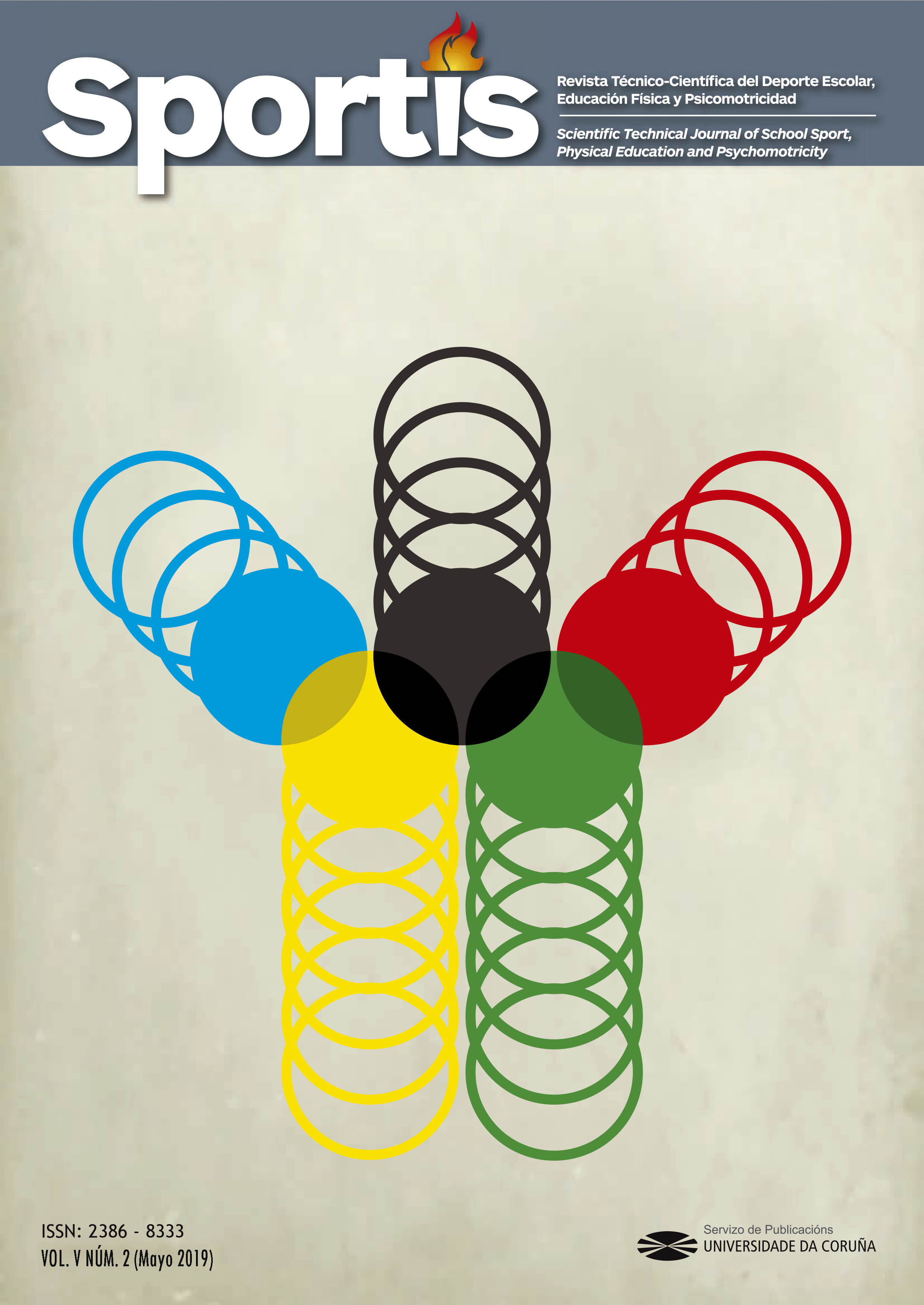Validación y fiabilidad de un test para evaluar la coordinación óculo manual y agilidad en gimnasia rítmica
Contenido principal del artículo
Resumen
El objetivo de este estudio fue desarrollar y validar un test que permita evaluar la coordinación óculo manual y agilidad en gimnastas de rítmica. Un panel de expertos se responsabilizó de la selección de las tareas que conformaron la composición inicial del test. Una vez constituido y validado mediante la opinión de expertos de forma unánime, el test se aplicó a una muestra de 60 gimnastas de 12 a 18 años (Media Edad= 13,76 ±1,53; Talla= 1,54 ± 0,065 y Peso= 44,78 ± 6,55). La fiabilidad del test mediante el cálculo de la consistencia interna a través de Alfa de Cronbach fue de .885 siendo el coeficiente de correlación del test-retest de .799 Se concluye que el test es un instrumento válido y fiable para medir la coordinación en gimnastas.
Palabras clave:
Descargas
Detalles del artículo
Citas
Adam, W., Kiefer, A., Michael, A., Riley, A., Shockley, K., Candace , A., & Jacqui G. (2011). Multi-segmental postural coordination in professional ballet dancers . Gait & Posture. 34, 76-80. https://doi.org/10.1016/j.gaitpost.2011.03.016
Castañer, M., & Camerino, O. (1991). La Educación Física en la enseñanza primaria. Barcelona: Inde.
Chelladurai, P., & Yuhasz, M. (1977). Agility performance and consistency. Canadan Journal Applied Sport Science, 2, 37-41.
García-Cantó, E., & Vigueras, J.M. (2010). Programa de integración de un alumno motórico en contenidos de coordinación óculo-manual de segundo ciclo de primaria. En Arnaiz, P., Hurtado, M.D., & Soto, F.J. (Coords.) 25 Años de Integración Escolar en España: Tecnología e Inclusión en el ámbito educativo, laboral y comunitario. Murcia: Consejería de Educación, Formación y Empleo. Journal of Sports Science and Medicine (2013) 12, 182-189. https://doi.org/10.18294/rdi.2017.172970
Grande Rodríguez, I., Bautista Reyes A., & Hontoria Galán, M. (2008). Biomecánica aplicada al diseño de una Herramienta de Evaluación de los saltos en Gimnasia Rítmica atendiendo al Código Internacional de Puntuación. Aplicación a la evaluación del salto zancada. Apunts: Educación física y deportes. 55-61. https://doi.org/10.6035/14110.2018.430307
Di Cagno, A., Battaglia, C., Giombini, A., Piazza, M., Fiorilli, G., Calcagno, G. & Borrione, P. (2013). Time of Day – Effects on Motor Coordination and Reactive Strength in Elite Athletes and Untrained Adolescents. Journal of Sports Science and Medicine. 12, 182-189. https://doi.org/10.1260/1747-9541.9.4.615
Di Cagno, A., Battaglia, C., Fiorilli, G., Piazza, M., Giombini, A., Fagnani, F. & Pigozzi, F. (2014). Motor Learning as Young Gymnast’s Talent Indicator. Journal of Sports Science and Medicine. 13, 767-773.
Holmberg, P. (2009). Agility Training for Experienced Athletes: A Dynamical Systems Approach. Strength and Condicioning Journal, 31(5), 73-78. https://doi.org/10.1519/ssc.0b013e3181b988f1
Hume, P. A., Hopkins, W. G., Robinson, D. M., Robinson, S. M., & Hollings, S. C. (1993). Predictors of attainment in rhythmic sportive gymnastics. The Journal of Sports Medicine & Physical Fitness, 33(4), 367-377.
Kline, R. (2005). Principles and practice of structural equation modeling (2ª ed.). New York: The Guilford Press. (2006). Experimental Brain Research. 175, 321-331.
Lepelley, M. C., Thullier, F., Koral, J., & Lestienne, F.G. (2006). Muscle coordination in complex movements during Jeté in skilled ballet dancers. Experimental Brain Research, 175, 321-331. https://doi.org/10.1007/s00221-006-0552-1
Mark, D., Sleeper, L., Kenyon, K., & Casey, E. (2012). Measuring fitness in female gymnasts: the gymnastics functional measurement tool. The International Journal of Sports Physical Therapy. 7,(2).
Moskovljević, L., & Orlić, A. (2012). Relations between students’ abilities and attitudes and success in rhythmic gymnastics – gender specificities. Physical Culture, 66(2), 129-137. https://doi.org/10.5937/fizkul1202129m
Nunnally, J., & Bernstein, Y. (1995). Teoría psicométrica. México: McGraw-Hill.
Purenović-Ivanović, T., Popović, R., Stanković, D., & Bubanj, S. (2016). The importance of motor coordination abilities for performance in rhythmic gymnastics. Physical Education and Sport, 14, (1), 63-74.
Rodrigues, P., Vasconcelos, O., Barreiros, J., & Barbosa, R. (2009). Manual asymmetry in a complex coincidence-anticipation task: handedness and gender effects. Laterality, 14(4), 395-412. https://doi.org/10.1080/13576500802469607
Ruiz-Pérez, L.M., Barriopedro-Moro, M. I., Ramón-Otero, I., Palomo-Nieto, M., Riojano-Collado, N., García-Coll, V., & Navia-Manzano, J. A. (2017). Evaluar la Coordinación Motriz Global en Educación Secundaria: El Test Motor SportComp RICYDE. Revista internacional de ciencias del deporte, 49 (13), 285-301. https://doi.org/10.5232/ricyde2017.04907
Serpell, B.G., Ford, M., & Young, W.B. (2009). The development of a new test of agility for rugby league. J Strength Conditining Research, 0(0) 1-8.
Sheppard, J.M., Young, W.B., Doyle, T.L.A., Sheppard, T.A., & Newton, R.U. (2006). An evaluation of a new test of reactive agility and its relationship to sprint speed and change of direction speed. Journal Science Medicine Sport, 9, 342-349. https://doi.org/10.1016/j.jsams.2006.05.019
Thullier, F. (2004) Hicham MouftiMulti-joint coordination in ballet dancers, Neuroscience Letters, 369, 80–84. https://doi.org/10.1016/j.neulet.2004.08.011
Τsopani, D., Dallas, G., Tasika, N., & Tinto, A. (2012). The effect of different teaching systems in learning rhythmic gymnastics apparatus motor skills. Science of Gymnastics Journal, 4(1), 55-62.
Vandorpe, B., Vandenriessche, J., Vaeyeans, R., Pion, J., Matthys, S., Lfevre, J. & Lenoir, M. (2012). Relationship between sports participation and the level of motor coordination in childhood: A longitudinal approach. Journal of Science and Medicine in Sport, 15 (3), 220-225. https://doi.org/10.1016/j.jsams.2011.09.006
Vandorpe, B., Vandenriessche, J.B., Vaeyeans, R., Pion, J., Lefevre, J.. Philippaerts, R.M., & Lenoir, M. (2012). The value of a non-sport-specific motor test battery in predicting performance in young female gymnasts. Journal of Sport Sciences, 30 (5), 497-505. https://doi.org/10.1080/02640414.2012.654399







